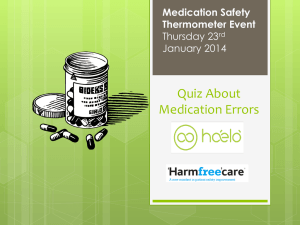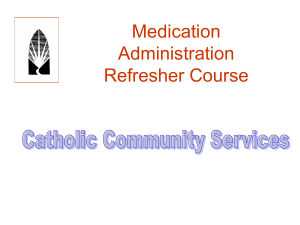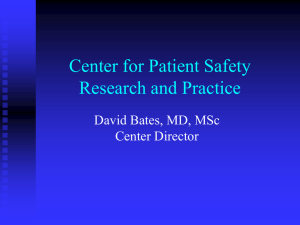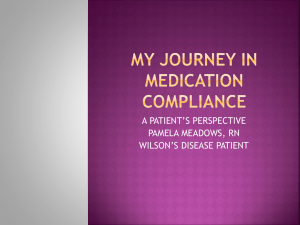Standard 4: Medication Safety - Australian Commission on Safety
advertisement
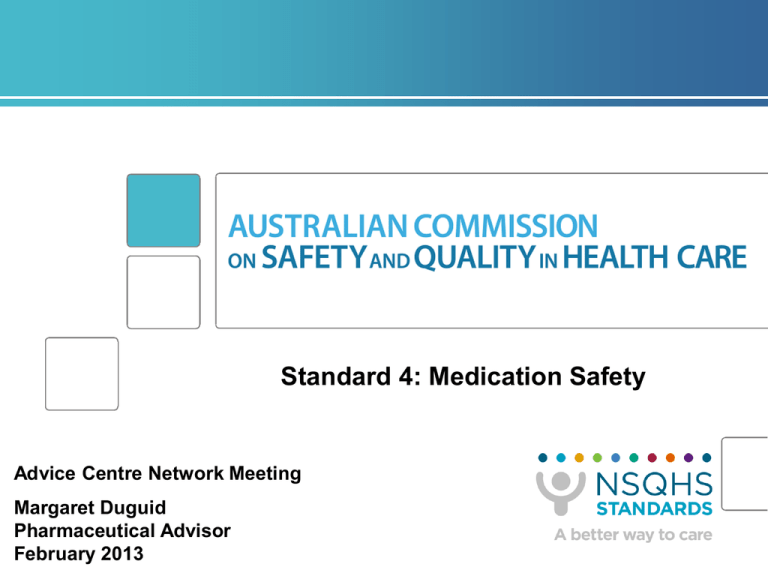
Standard 4: Medication Safety Advice Centre Network Meeting Margaret Duguid Pharmaceutical Advisor February 2013 Intent of Standard 4 – Medication Safety Ensure competent clinicians safely prescribe, dispense, and administer appropriate medicines safely to informed patients and carers • Reduce medication incidents, adverse events • Improve safety and quality of medicine use. Standard 4 Medication Safety Standard 4 – Medication Safety The Medication Safety Standard describes the elements of a safe medication management system. It requires hospitals have in place strategies and systems known to reduce the risk of common causes of medication error. • standardisation and systemisation of processes • improving clinical workforce and clinician-patient communication • using technology to support information recording and transfer • providing better access to patient information and clinical Standard 4 decision support at the point of care. Medication Safety Five criteria (Part 1) 1. Governance and systems for medication safety • 2. Documentation of patient information • 3. Health service organisations have mechanisms for the safe prescribing, dispensing, supplying, administering, storing, manufacturing, compounding and monitoring of the effects of medicines. The clinical workforce accurately records a patient’s medication history and this history is available throughout the episode of care. Medication management processes • The clinical workforce is supported for the prescribing, dispensing, supplying, administering, storing, manufacturing, compounding and monitoring of medicines. Standard 4 Medication Safety Five criteria (Part 2) 4. Continuity of medication management • The clinician provides a complete list of a patient’s medicines to the receiving clinician and patient when handing over care or changing medicines. 5. Communicating with patients and carers • The clinical workforce informs patients about their options, risks and responsibilities for an agreed medication management plan. Standard 4 Medication Safety 1. Governance and systems for med safety 4.1 Governance arrangements and organisation policies • Group/Committee • Responsible for medication safety • Reports to executive/management • Day procedure service • Facility manager, specialist clinicians (Anaesthetist in day surgeries), nurse ± pharmacist Standard 4 Medication Safety 1. Governance and systems for med safety - Policies www.safetyandquality.gov.au/our-work/medication-safety/ Resources, list of jurisdictional contacts 1. Governance and systems for med safety 4.5.2 Quality improvement activities Q Do Day procedure services have to follow labelling recommendations? • Yes. Where Aust & NZ Standards for labelling medicines in syringes in anaesthesia do not apply. • Label containers, conduits for medicines, fluids in perioperative area Standard 4 Medication Safety Private Hospitals Day Surgery Chart Q. Many facilities only give sedation, anaesthetic, and pain relief or anti-emetics post op. How relevant is national medication chart? http://www.safetyandquality.gov.au/our-work/medication-safety/medicationchart/private-hospital-and-private-hospital-day-surgery-nimc/ 1. Governance and systems for med safety 4.2 Assess medication use system • How? • Use Accreditation Workbook to guide assessment - ANZCA Guidelines for administration anaesthetic agents • Identify what you are doing well, evidence to demonstrate actions have been met • Identify areas for improvements • Develop an action plan. • Q Do we have to action all problems identified • Prioritise areas using risk matrix • http://www.safetyandquality.gov.au/ourwork/accreditation/accreditation-newsroom/ Documentation of patient information 4.6.1 Document “best possible” medication history Q. Do you need to document a medication history? A. All patients should have a medication history taken prior to prescribing medicines • Documented in patient record • At pre-admission 4.8.1 Medicines are documented and reconciled • Not applicable to day procedure services Standard 4 Medication Safety Documentation of patient information 4.7 Documenting previous known allergies, adverse drug reactions (ADRs) Q. Where should allergies and ADR information be recorded ? • Medication chart – “Source of truth” • Other charts - Cross reference to NIMC • Electronic health record • One source in EHR • Active transfer information to e- medication management system, pharmacy system • On prescribing screen • Active alerts Standard 4 Medication Safety Medication management processes 4.11 Managing high risk medicines Q. What is a high risk medicine? • Medicines that have a high risk of causing serious injury or death to a patient if they are misused • Errors with these products are not necessarily more common, but the effects can be more devastating. • PINCH/APINCH, neuromuscular blocking agents • Institute of Safe Medication Practices list • www.safetyandquality.gov.au/our-work/medicationsafety/medication-alerts/ Q. Can we prioritise actions to address risks with high risk Standard 4 Medication medicines? Safety Medication management processes 4.10.2 Use Tall Man Lettering in storage and labelling Q. Is Tall Man Lettering applicable to a day surgery ? • Use on shelf/drawer labelling where there are confusable names Q. Should doctors use Tall Man Lettering on their scripts? • Only for names on labels, shelving, It (e-prescribing systems) Standard 4 Medication Safety Continuity of medication management 4.12 Current, comprehensive list of medicines provided to receiving clinician and patient at clinical handover Q. Does 4.12. apply to day procedure services, dental services? • Referring doctor informed of changes to medicines • Patient informed of changes, amend patients own list Standard 4 Medication Safety Communicating with patients and carers 4.14 Information provided to patients and carers in a format that is understood and meaningful Q. Most patients are given a script to have filled by their local pharmacists. How much information does facility have to give the patient? • Community pharmacy should give Consumer Medicines Information • Facility verbal information , documented in notes • If use prepacks – include CMI . Standard 4 Medication Safety Medication Safety Standard: Summary Ensuring that competent clinicians safety prescribe, dispense and administer appropriate medicines to informed patients and carers is an essential element of safe and high quality care. Purpose of the Standard is to improve outcomes for patients by ensuring that there is a systematic approach to medicines management and safety Outcomes to be achieved are clear – methods to get there will vary depending on context Standard 4 Medication Safety Australian Commission on Safety and Quality in Health Care Medication Safety Program www.safetyandquality.gov.au Email: mail@safetyandquality.gov.au Margaret.duguid@safteyandquality.gov.au




